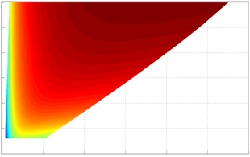
Based on patented high rotor pole SRM technology, this prototype SRM was designed for comparative evaluation. It was rated for 300V, 300W, and 1500RPM for general purpose applications. The prototype was fully correlated with simulation results and fully tested for static characterization.

An induction machine design was analyzed using 2D FEA. A transient analysis was performed to evaluate the startup current and torque during line start. Fully transient torque vs. speed curve was also generated to verify if the design met the requirements.

Using FEA transient analysis and a special design tool, a detailed efficiency map of a PM machine was generated to analyze the performance, power losses, and thermal stability at various operating points.

Control algorithm for an eight axes servo system was developed. Extensive simulations were performed to verify the reference tracking, disturbance rejection, and dynamic stiffness. Proprietary technology resulted in superior synchronization between master and slave axes.

This permanent magnet generator, used for a mission critical aerospace application, has built in redundancy and some unique application specific challenges. The design also required 3D FEA analysis. Thousands of designs were evaluated in virtual world to converge to the best possible solution for prototyping & testing.

Before finalizing key design specifications, a detailed engineering analysis of the application was performed at the front end. Such an analysis provided valuable insight to the boundary conditions and clearly identified design trade-offs that led to informed design choices.

For high accuracy feedback sensing application, this design project leveraged multiple simulation tools and used innovative approaches to solve seemingly impossible puzzle. Thousands of design iterations were performed to arrive at few candidate designs for prototyping and then production.

For a customized electric motor, multiple candidate design were generated that best fit the performance requirements. However, only when they were compared using innovative performance indexes, the differences between two seemingly same designs became apparent.

High performance servo systems rely on robust control system to meet demanding performance requirements. Using dynamic stiffness and eigenvalue migration chart as performance matrix, detailed trade off study between various control schemes (classical cascaded, state feedback, feed-forward,…) was performed to evaluate the right fit.

A system model is quite helpful in control algorithm development. However, SRM posed some unique challenges due to nonlinear characteristics, which were circumvented by using a look up table based approach in Simulink. The model, capable of transient and dynamic simulations, was further validated by correlating the torque – speed curves.

Current regulation in a surface permanent magnet machine is challenging at higher speed, especially with higher number of rotor poles. DSP based digital controller adds up additional complexities. Various design approaches were analyzed that gave interesting insights to finally arrive at a novel controller structure for such applications.

Efficiency at various operating speed and torque was predicted using fully transient FEA analysis. Such transient model also included power electronics based inverter and hysteresis current controller to representative the SRM drive.

Manufacturing tolerances, imperfections, and assembly variations introduced eccentricity. Using FEA analysis, the force imbalance caused by the eccentricity was estimated to further verify the mechanical integrity and bearing loads.
